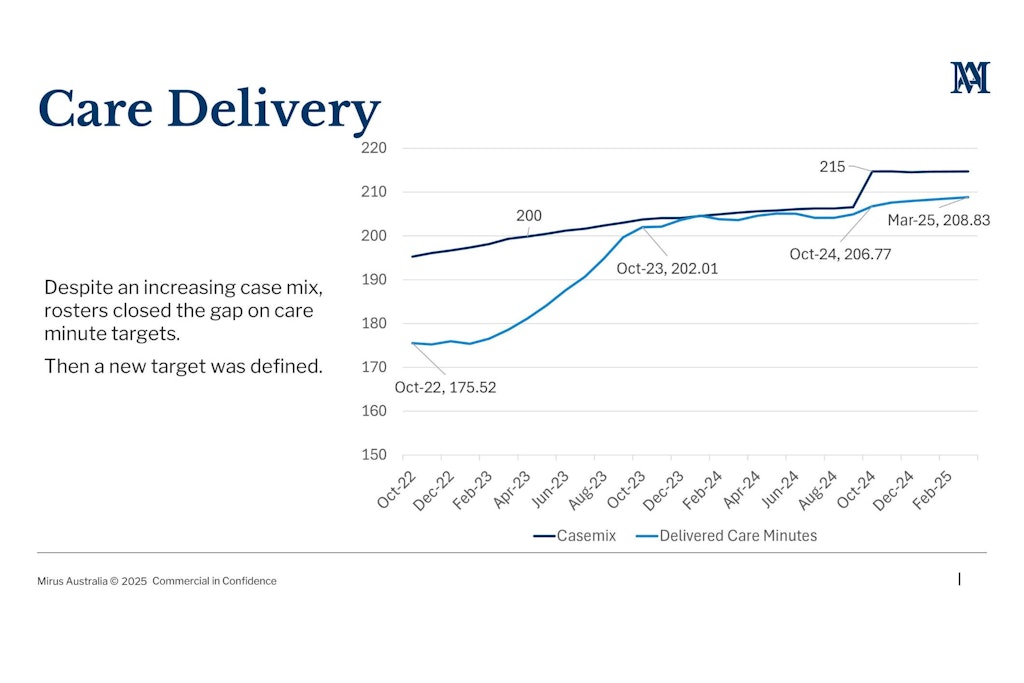Rostering evolution supports care minutes compliance
Last updated on 29 April 2025

Aged care providers are increasingly turning to centralised rostering systems to support their care minutes management and ensure compliance with evolving targets.
In a recent webinar hosted by Mirus Australia, How care minutes are reshaping the future of aged care, three industry leaders shared their insights into care minutes and staffing management: Alyson Jarrett, Deputy Chief Executive Officer (CEO), Whiddon; Jo Boylan, CEO, Clayton Church Homes; and Donna Hart, CEO, Churches of Christ QLD.
The trio shared valuable insights into the changes they have implemented in recent years to strengthen their approach to care minutes and the AN-ACC funding model.
For Ms Jarrett and Whiddon, the key to their success is the ability to directly monitor whether they’re providing the care levels they’re funded for. She said there is always the risk that an organisation is providing too much or too little care in relation to AN-ACC without the best data available.
“We felt it was important to invest in systems and technology that will give us a day to day view of how we’re meeting the care minutes. We’re now meeting targets that were set a quarter ago. Being able to look at how those targets are applied to the current quarter is key,” she explained.
“We’re looking at how best we can stabilise master rosters, our resident reassessments, and the resident needs to ensure they’re being met through the care minutes and trying to smooth that target as much as possible between every single quarter.”
Mirus Australia data from March, 2025, reveals that the sector’s care minutes average is just under seven minutes short of where it needs to be: with an industry average target of 215 care minutes per resident per day, the sector is delivering 208.83 minutes.
After making up considerable ground when the target of 200 care minutes was first introduced in 2023, the jump to 215 care minutes in October, 2024, raised the bar just beyond the reach of many providers.

Most, if not all, are faced with the difficult task of getting the balance right for their new casemix adjusted targets. Ms Jarrett said the greatest challenge is to remain malleable enough to meet the target without having to always recruit or reduce the master roster.
“It’s a fine balance to achieve that target. Traditionally, all of the homes have rostered themselves but we’re moving towards a centralised, hybrid rostering model to support the homes,” Ms Jarrett said.
This move would reduce the burden on service managers who are coordinating care minutes, occupancy, rosters and more everyday. Instead, centralised management would provide greater oversight in ensuring rosters are aligned with care minute targets without taking away from support on the floor.
Clayton Church Homes has also introduced centralised rostering as part of a broader approach to strengthening not only its care minutes management, but also recruitment and care delivery.
Ms Boylan said they found the refer-a-friend model where staff are paid to refer new workers extremely beneficial in conjunction with traditional recruiting methods. The organisation also rostered 2–4 backfill staff who could be available in case of sudden illness. Both methods helped to reduce Clayton Church Homes’ agency reliance while maintaining staffing levels and workforce morale.
She added that care minute meetings have also strengthened care minutes success.
“In our care minute meetings, we’re looking at whether we are fulfilling our requirements while we’re also talking directly with the site managers to find out if they have enough staff, etc. We’re planning better than we had before,” Ms Boylan said.
“This includes reducing some of the pressure at the sites and making it a little bit easier to provide these minutes. For example, we developed a customer journey team and that customer journey team is dedicated to onboarding a new resident when they transition to care. That takes a lot of pressure off of the registered nurse on the floor. Admission is direct care so it’s all claimable but it relieves some of the pressure for the person managing the shift.”
Addressing challenges in regional Australia
Meeting care minutes targets is slightly different for regional, rural and remote organisations, and Churches of Christ QLD is no different. With an even spread of metropolitan and rural and remote homes, Ms Hart said the organisation has encountered additional pressures and issues linked to filling registered nurse positions.
This included having to introduce housing incentives, higher wages and a strong employee value proposition.
“It’s ensuring that we could win over hearts and minds to bring different cohorts into the aged care sector. We definitely looked at a wide variety of strategies around seeking out cohorts that wouldn’t normally be the applicants that we see and understanding from a heartstring point of view what they have to offer,” Ms Hart explained.
“Those people are unlikely to come with their certificates so there is an additional burden around training and support. One of the other things we’ve been trying to do more is to grow our own nurses internally with the people that have aspirations to become registered nurses. So what incentives can we give them, what assistance can we give them to go further and receive those qualifications.”
This focus on training and recruitment, when combined with increased support for service managers, means the organisation has strengthened its care minutes coordination. Like the other providers, Ms Hart said they have plenty of visibility about current care minute requirements, whether they’re meeting them or overservicing them, and what levers need to be pulled through rostering.
“We have critical thinking conversations all the time around ‘Do I need to replace this shift because of the change that occurred yesterday’. A lot of energy and effort is placed into ensuring we have the data available and it’s available to the right people so that informed decisions can be made,” she added.
“That also speaks to a heavy administrative burden that’s come our way, particularly if you have to organise agency staff to fill a gap. The flow on is that an agency staff member has to be onboarded and oriented. Then there’ll be an increased compliance monitoring piece and we have to be careful there’s no gaps following that engagement with that agency staff member.”
Controlling data and achieving balance

In the two years since the AN-ACC funding model was introduced, compliance rates have shifted significantly. The percentage of 3-star organisations has increased from 22.9% to 46.9%, while the percentage of 1-star organisations has decreased from 22.3% to just 1.7%.
This shows that more organisations are in control of their AN-ACC funding. As Mirus Founder Rob Covino explained, the success here comes down to a balanced model where rosters are aligned to demand — as is the case with the organisations that featured in the webinar.
“Being in control of AN-ACC is about controlling the data and having transparency. The first step is about the normalisation of the AN-ACC classes, looking at it through a very balanced model and distribution and aligning the roster and demand templates to that target star rating and occupancy levels,” Mr Covino said.
“If you’re in control of the data, you’re then in a better position to strategically request resident classifications that align to this balanced approach instead of peaking and troughing and going from an overspend to a non-compliant area and continually chasing. It’s about the smoothing effect of those business operations.”
Mr Covino added that more collaboration between rostering is crucial as providers have to be thinking a fortnight in advance while also understanding what’s occurring with resident/classification changes and in funding teams. Without the ability to look forward, providers could be caught out chasing outdated targets.